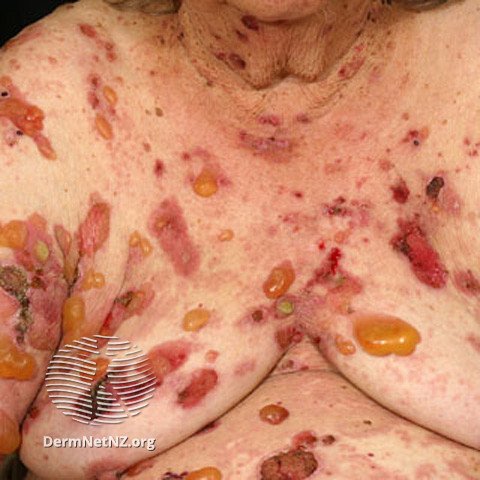
Blistering Disorders
An example of bullous pemphigoid, a blistering disorder, which presents with tense fluid-filled itchy blisters
Credit: DermNet NZ
What are blistering disorders?
Blistering disorders encompass a range of autoimmune diseases, including conditions like bullous pemphigoid, pemphigus, and others. These disorders lead to the formation of blisters on the skin, mouth, or other mucous membranes. The specific characteristics and dimensions of the blisters vary based on the underlying disease. Generally, the incidence of these disorders increases with age. Any unexplained blistering should be promptly assessed by a board-certified dermatologist.
What causes blistering disorders?
The primary cause of blistering disorders is typically autoimmune, where the body's antibodies mistakenly attack skin and/or mucous membrane cells. The precise reasons remain uncertain, but several factors can contribute to the onset of these disorders:
Age (e.g., bullous pemphigoid is more prevalent in individuals over 60, while pemphigus is common between ages 40-60)
Specific medications (including some diabetes drugs, blood pressure medications, antibiotics, and certain biologics)
Genetic predispositions (e.g., pemphigus is more frequent among Jewish and Indian populations)
A history of cancer
What are the symptoms of blistering disorders?
A hallmark symptom across blistering disorders is the appearance of multiple itchy or painful blisters of unknown origin. Upon rupturing, these blisters reveal underlying ulcers or erosions. Additional symptoms, contingent on the specific disorder, include:
In pemphigus, mucosal blistering often precedes skin blistering by weeks to months, and the blisters tend to be flaccid.
Oral blistering can cause difficulty or pain during swallowing.
In bullous pemphigoid, blisters are usually large, tense, and highly itchy.
Preceding appearance of hives or target-like rashes before the onset of blisters.
Presence of smaller blisters or vesicles.
Tiny white bumps on the skin post-healing.
The onset of blistering shortly after starting a new medication, especially accompanied by target-like skin lesions or if the blistering is sudden and affects the mouth, genitals, or eyes, warrants immediate medical attention. This could indicate Stevens-Johnson syndrome, a medical emergency.
How do I treat blistering disorders?
The treatment approach for blistering disorders hinges on the severity and affected areas. Potential treatment options encompass:
Oral steroids (e.g., prednisone)
Doxycycline/nicotinamide as an alternative to steroids
Antibiotics to tackle secondary bacterial infections
Immunosuppressive drugs (such as azathioprine, mycophenolate, or cyclophosphamide)
Biologic agents (e.g., rituximab)
An example of pemphigus vulgaris, a blistering disorder
Credit: DermNet NZ
Bullous impetigo, an infection that can present as blistering lesions.
Credit: DermNet NZ



